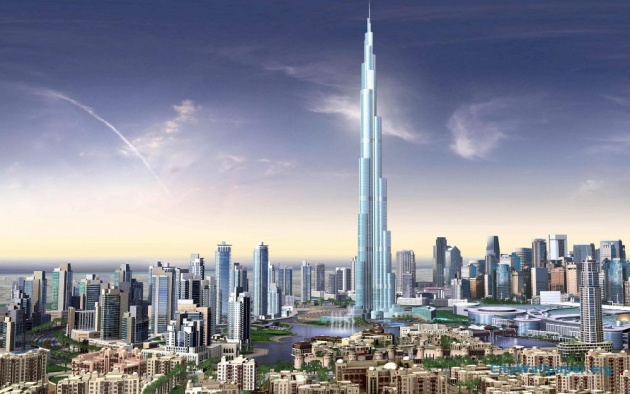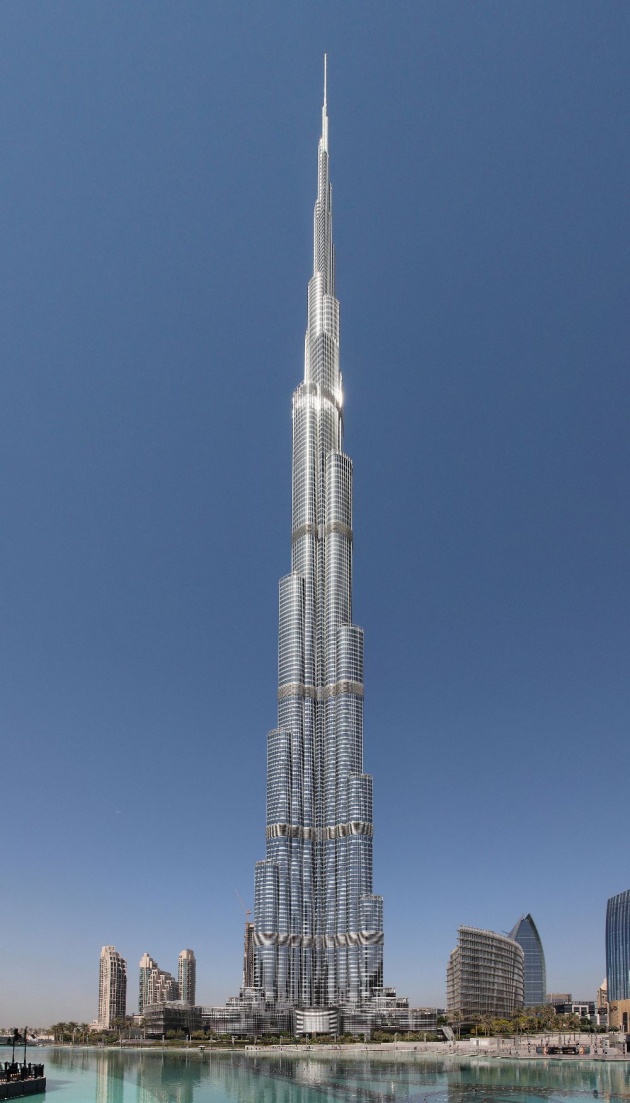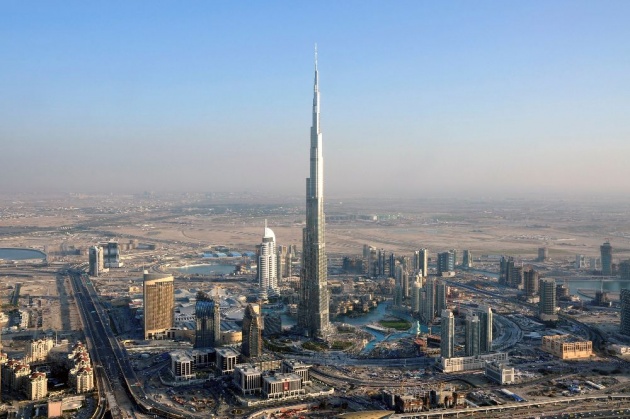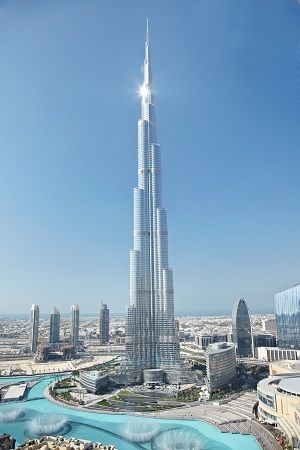Burj Khalifa
Burj Khalifa (Arabic: برج خليفة, "Khalifa Tower", pronounced English known as Burj Dubai before its inauguration, is a megatall skyscraper in Dubai, United Arab Emirates. It is the tallest artificial structure in the world, standing at 829.8 m (2,722 ft).
Construction of Burj Khalifa began in 2004, with the exterior completed in 2009. The primary structure is reinforced concrete. The building opened in 2010, as part of the new development called Downtown Dubai. It is designed to be the centerpiece of large-scale, mixed-use development. The decision to build the building is reportedly based on the government's decision to diversify from an oil-based economy, and for Dubai to gain international recognition. The building was named in honor of the ruler of Abu Dhabi and president of the United Arab Emirates, Khalifa bin Zayed Al Nahyan; Abu Dhabi and the UAE government lent Dubai money to pay its debts. The building broke numerous height records.

Burj Khalifa was designed by Adrian Smith then of Skidmore, Owings and Merrill (SOM), whose firm also designed the Willis Tower and the One World Trade Center. Hyder Consulting was chosen to be the supervising engineer with NORR Group Consultants International Limited chosen to supervise the architecture of the project. The design of Burj Khalifa is derived from patterning systems embodied in Islamic architecture, incorporating cultural and historical elements particular to the region such as the spiral minaret. The Y-shaped plan is designed for residential and hotel usage. A buttressed core structural system is used to support the height of the building, and the cladding system is designed to withstand Dubai's summer temperatures. A total of 57 elevators and 8 escalators are installed, with the elevators having a capacity of 12 to 14 people per cabin.
Development
Construction began on 6 January 2004, with the exterior of the structure completed on 1 October 2009. The building officially opened on 4 January 2010,and is part of the new 2 km2 (490-acre) development called Downtown Dubai at the 'First Interchange' along Sheikh Zayed Road, near Dubai's main business district. The tower's architecture and engineering were performed by Skidmore, Owings and Merrill of Chicago, with Adrian Smith as chief architect, and Bill Baker as chief structural engineer.[10][11] The primary contractor was Samsung C&T of South Korea.The tower's construction was done by the construction division of Al Ghurair Investment group.

Conception
Burj Khalifa was designed to be the centerpiece of a large-scale, mixed-use development that would include 30,000 homes, nine hotels (including The Address Downtown Dubai), 3 hectares (7.4 acres) of parkland, at least 19 residential towers, the Dubai Mall, and the 12-hectare (30-acre) man-made Burj Khalifa Lake. The decision to build Burj Khalifa is reportedly based on the government's decision to diversify from an oil based economy to one that is service and tourism based. According to officials, it is necessary for projects like Burj Khalifa to be built in the city to garner more international recognition, and hence investment. "He (Sheikh Mohammed bin Rashid Al Maktoum) wanted to put Dubai on the map with something really sensational," said Jacqui Josephson, a tourism and VIP delegations executive at Nakheel Properties. The tower was known as Burj Dubai ("Dubai Tower") until its official opening in January 2010.It was renamed in honor of the ruler of Abu Dhabi and president of the United Arab Emirates, Khalifa bin Zayed Al Nahyan; Abu Dhabi and the federal government of UAE lent Dubai tens of billions of USD so that Dubai could pay its debts – Dubai borrowed at least $80 billion for construction projects.In 2000s, Dubai started diversifying its economy but it suffered from an economic crisis in 2007–2010, leaving large scale projects already in construction abandoned.

History of height increases
There are unconfirmed reports of several planned height increases since its inception. Originally proposed as a virtual clone of the 560 m (1,837 ft) Grollo Tower proposal for Melbourne, Australia's Docklands waterfront development, the tower was redesigned by Skidmore, Owings and Merrill (SOM).Marshall Strabala, an SOM architect who worked on the project until 2006, in late 2008 said that Burj Khalifa was designed to be 808 m (2,651 ft) tall
The design architect, Adrian Smith, felt that the uppermost section of the building did not culminate elegantly with the rest of the structure, so he sought and received approval to increase it to the current height.[citation needed] It has been explicitly stated that this change did not include any added floors, which is fitting with Smith's attempts to make the crown more slender.




